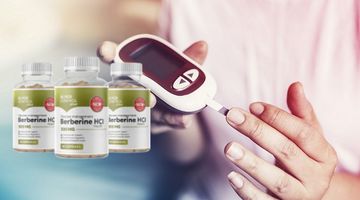Click here — Official site — Order now
⚠️Limited stock alert!⚠️
✔To order the official website — https://healthshive.com/go-glycocontrolplusuk/
✔Product name — Glyco Control
✔Secondary effect – No secondary effect
✔Availability — Online
Glyco
Control typically refers to a concept, product, or therapeutic approach
aimed at managing or regulating blood sugar levels, particularly in the
context of diabetes or prediabetes. The term "glyco" refers to glucose
(sugar), and "control" refers to managing or stabilizing blood glucose
levels. It may be used in relation to dietary supplements, medications,
or lifestyle strategies designed to help individuals maintain healthy
glucose metabolism.
Uses:
Uses
of Glyco Control depend on its specific application, which can range
from products designed to help manage blood glucose levels to broader
approaches for preventing or managing conditions like diabetes. Below
are common uses of Glyco Control in different contexts:
1. Blood Sugar Management (Diabetes & Prediabetes)
Glyco Control in Medications: It is used in the context of managing
blood sugar in people with Type 2 diabetes or prediabetes. Medications
and supplements that focus on glyco control help individuals maintain
balanced blood glucose levels, reducing the risk of complications like
cardiovascular disease, kidney failure, or nerve damage.
Insulin Sensitivity: Some approaches to glyco control help increase
insulin sensitivity, making the body more efficient at using insulin and
managing blood sugar. This is particularly important for people with
insulin resistance, which is common in Type 2 diabetes.
Blood
Sugar Regulation: Glyco control may involve products or strategies to
lower fasting blood glucose or reduce post-meal blood sugar spikes.
2. Dietary & Lifestyle Support
Weight Management: Glyco control strategies often include lifestyle
changes that support healthy weight management, which can positively
impact insulin resistance and glycemic control.
Balanced
Nutrition: It involves promoting the consumption of low glycemic index
foods, high-fiber foods, and balanced meals to avoid blood sugar
fluctuations. A diet rich in healthy fats, lean proteins, and whole
grains is common in glyco control approaches.
Exercise:
Regular physical activity is encouraged as part of glyco control, as it
helps improve insulin sensitivity and lowers blood glucose levels.
➲ Where to buy: → Order from the official Glyco Control website
Benefits:
The
benefits of Glyco Control are centered around the regulation and
management of blood glucose levels. Whether through medication, dietary
changes, or supplements, effective glyco control provides numerous
health benefits, especially for individuals with diabetes or those at
risk of developing diabetes. Here are the primary benefits:
1. Improved Blood Sugar Control
Stable Blood Glucose Levels: Glyco control helps maintain blood sugar
levels within a normal range, preventing spikes (hyperglycemia) or drops
(hypoglycemia). This is crucial for people with Type 1 and Type 2
diabetes, as well as those with prediabetes.
Reduced Insulin
Resistance: For individuals with insulin resistance, glyco control
improves the body’s ability to respond to insulin, making it more
efficient at lowering blood glucose.
2. Prevention and Management of Diabetes
Prevents Progression to Type 2 Diabetes: For people with prediabetes,
glyco control through lifestyle changes, diet, and sometimes medication
can delay or prevent the onset of Type 2 diabetes.
Improved
Insulin Sensitivity: Glyco control interventions can increase the body's
ability to use insulin effectively, reducing the need for higher levels
of insulin production and lowering the risk of developing Type 2
diabetes.
3. Reduced Risk of Complications
Prevention
of Long-term Complications: Maintaining healthy blood sugar levels helps
to lower the risk of diabetic complications, such as:
Cardiovascular diseases (heart disease, stroke)
Neuropathy (nerve damage)
Diabetic retinopathy (vision problems)
Diabetic nephropathy (kidney damage)
Reduced Inflammation and Oxidative Stress: Glyco control helps decrease
inflammation and oxidative stress, which are linked to many
diabetes-related complications.
How to use:
How
to use Glyco Control depends on the specific product or approach you're
referring to—whether it's a medication, supplement, or lifestyle
strategy. Below are general guidelines for the different types of glyco
control methods:
1. Glyco Control Medications (For Diabetes Management)
If
Glyco Control refers to a medication or pharmaceutical product aimed at
managing blood sugar, it’s important to follow your healthcare
provider’s instructions. Common medications used to control blood
glucose include:
Oral Medications: For example, metformin,
sulfonylureas, or SGLT-2 inhibitors. These are typically taken once or
twice daily with meals to help lower blood sugar levels.
How
to use: Take as prescribed by your doctor. It's important to take them
at the same time each day and consistently monitor blood glucose levels.
Insulin: If insulin is part of your glyco control regimen, it’s injected into the body to regulate glucose levels.
How to use: Follow your doctor’s instructions regarding insulin type,
dosage, and timing (typically before meals or at bedtime). Some
individuals may also need to adjust doses based on blood glucose
monitoring.
GLP-1 Agonists or DPP-4 Inhibitors: These
medications can help regulate insulin production and reduce glucose
production by the liver.
How to use: These are usually
injectable or oral medications. Injectables may be taken once a week or
daily, depending on the specific drug.
Note: Always follow the prescription guidelines provided by your healthcare provider and monitor your blood sugar regularly.
2. Glyco Control Supplements (For Blood Sugar Support)
If
you're using dietary supplements marketed for glyco control, such as
cinnamon, berberine, chromium, or alpha-lipoic acid, here are general
guidelines:
Cinnamon: Often used as a powder or in capsule form.
How to use: Take 1-2 teaspoons of ground cinnamon per day (in food or
as a supplement), or follow the dosage recommendations on the product
label.
Berberine: Known for its potential to help regulate blood glucose.
How to use: Typically, the recommended dose is around 500 mg two to
three times a day, but consult with a healthcare provider before use.
Chromium: Helps improve insulin sensitivity.
How to use: The typical dose ranges from 200 to 1000 mcg daily. It's usually taken with meals.
Alpha-Lipoic Acid: An antioxidant that may help improve insulin sensitivity.
How to use: Standard dosages range from 300 to 600 mg daily, divided into two doses.
➲ Where to buy: → Order from the official Glyco Control website
Conclusion:
In
conclusion, Glyco Control plays a critical role in maintaining healthy
blood sugar levels, especially for individuals with diabetes,
prediabetes, or those at risk of developing metabolic disorders. By
incorporating appropriate methods, whether through medications, dietary
supplements, or lifestyle modifications, glyco control helps prevent the
complications associated with uncontrolled blood glucose levels, such
as heart disease, kidney damage, and nerve problems.
https://glyco-control-faejjl8.gamma.site/
https://glyco-control.webflow.io/
https://colab.research.google.com/drive/1IPuvqomkz-EqccWbmh9NXV20Feim6gcu?usp=sharing
https://hackmd.io/@fitexweight/GlycoControl
https://sites.google.com/view/glyco-control-/home
https://groups.google.com/g/glucovate58/c/m-ULdppZuwg
https://fitexweight.hashnode.dev/what-is-glyco-control-and-how-does-it-help-manage-blood-glucose
https://graph.org/What-is-Glyco-Control-and-how-does-it-help-manage-blood-glucose-01-21
上一篇:Bigpond Webmail Helpline: Your 24/7 Assistance Support
下一篇:Troubleshoot Bigpond Webmail Problems with Expert Support $$


